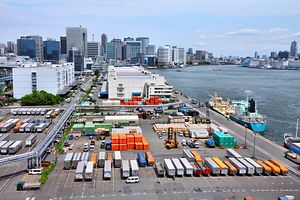Japan’s growth outlook has been upgraded while China and the rest of Asia have slipped in the latest reading on the global economy. However, world economic growth is still likely to take a turn for the better from the second quarter of 2014, according to the International Monetary Fund (IMF).
In its latest World Economic Outlook released Thursday, the Washington D.C.-based organization continued its theme of advanced economies leading the pack while emerging market and developing economies trail.
Global growth is predicted to rise from 3.4 percent this year to 4 percent in 2015, with this year’s performance cut 0.3 percentage point from the IMF’s April outlook on the back of a weak first quarter in the United States and reduced optimism over emerging economies. Nevertheless, next year’s growth forecast remained unchanged, while there were “surprise” upsides to activity in Japan and a number of European nations.
According to the IMF, growth disappointed in the world’s second-largest economy, China, due to a policy tightening to constrict credit growth and housing market activity. The IMF cut its growth forecasts for China from its April report by 0.2 percentage point, to 7.4 percent this year and 7.1 percent in 2015, with tax relief and other measures expected to aid its economy in the second half of 2014.
While the communist-ruled juggernaut announced 7.5 percent growth in gross domestic product (GDP) during the second quarter, in line with Beijing’s official target, China-watchers are increasingly concerned about rising debt levels that now exceed 200 percent of GDP, according to The Economist.
The picture was brighter for Japan, where an unexpectedly robust performance in the first quarter prompted the IMF to lift its 2014 projection for the world’s third-largest economy by 0.3 percentage point, to 1.6 percent GDP growth. However, the fund said growth would slip to 1.1 percent next year as Tokyo’s fiscal stimulus to offset April’s consumption tax hike unwound.
In its latest forecasts, the Bank of Japan has predicted GDP growth of 1 percent in the fiscal year to March 2015, with a similar level anticipated for inflation as it heads toward its expected 2 percent target.
For India, the IMF left its projections unchanged from April, at 5.4 percent growth in 2014 and 6.4 percent next year, despite investor enthusiasm for newly elected Indian Prime Minister Narendra Modi. According to the fund, “growth appears to have bottomed out…activity is projected to pick up gradually after the postelection recovery in business sentiment, offsetting the effect of an unfavorable monsoon on agricultural growth.”
However, emerging and developing Asia saw its growth outlook downgraded to a 6.4 percent expansion this year and 6.7 percent in 2015, down 0.2 percentage point and 0.1 percentage point respectively, due to tighter financial conditions and higher capital costs.
Among downside risks to its forecasts, the IMF cited geopolitical risks in Ukraine and the Middle East with the threat of a potential oil price spike, as well as a rise in longer-term interest rates caused by the “normalization” of monetary policy in the United States.
“Emerging market economies – particularly those with domestic weaknesses and external vulnerabilities – may face a sudden worsening of financial conditions and a reversal of capital flows in the event of a shift in financial market sentiment,” the IMF warned.
The fund called for continued “accommodative” monetary policy in advanced economies along with fine-tuning of fiscal policy adjustment, as well as policy options to support growth such as structural reform.
“Global growth could be weaker for longer, given the lack of robust momentum in advanced economies despite very low interest rates and the easing of other brakes to the recovery,” the IMF said. “In some major emerging market economies, the negative growth effects of supply side constraints and the tightening of financial conditions over the past year could be more protracted.”
ADB: Developing Asia on Track
Meanwhile, the Asian Development Bank has announced that “developing Asia” remains on track for steady growth in 2014, despite slower than expected growth in the United States in the first quarter.
In its Asian Development Outlook released July 18, the Manila-based lender maintained its April forecast of 6.2 percent growth this year and 6.4 percent in 2015 for the region’s 45 developing economies.
“Developing Asia as a region continues to perform well,” ADB deputy chief economist Juzhong Zhuang said in a statement. “The pace of the growth moderation in [China] is in line with our expectations while the stage is set for India to pursue reform that could unlock its growth potential.”
According to the ADB, China is expected to post growth of 7.5 percent this year and 7.4 percent in 2015, higher than the latest IMF forecasts, helped by stronger retail sales and industrial production.
The ADB said India’s improved growth prospects had helped the outlook for South Asia, with the new Modi government outlining a 10-point plan to revive the economy focusing on infrastructure and investment reforms and policy stability.
“While detail on the structural reforms remains limited, it is expected that greater political certainty will support a pickup in infrastructure investment,” the ADB said, maintaining its growth forecast for India at 5.5 percent in fiscal 2014 but upgrading it to 6.3 percent in fiscal 2015 on the back of anticipated reforms bearing fruit.
However, the outlook for Southeast Asia weakened due to reduced growth prospects in Indonesia, Thailand and Vietnam, a reflection of political factors in the latter two countries and lower commodity prices. The region saw its 2014 forecast cut by 0.3 percentage point to 4.7 percent, although it maintained its 2015 projection of 5.4 percent GDP growth.
For Asia, the message from the two reports appears to be similar to former Australian Prime Minister John Howard’s refrain about terrorism: “Be alert, but not alarmed.” Keeping regional rivalries in check would also help ease the “downside risks” flagged by the IMF, given the region’s growing interdependence.

































